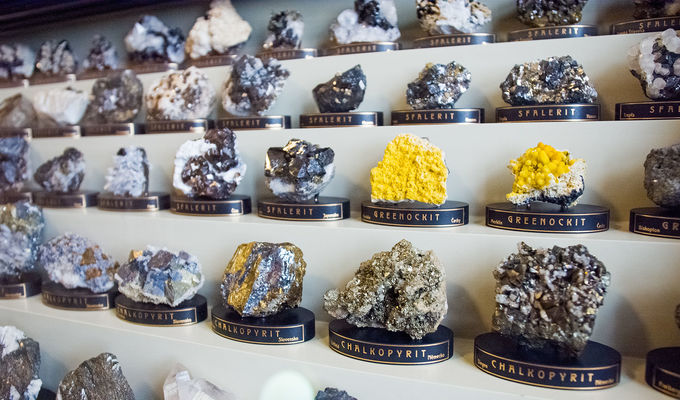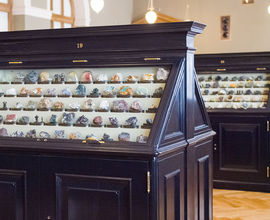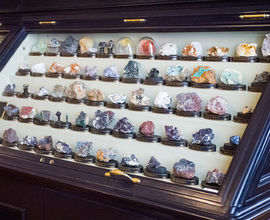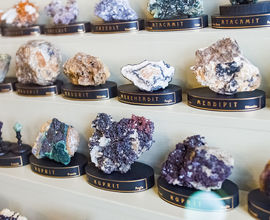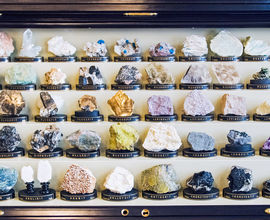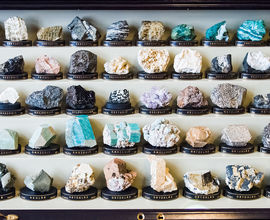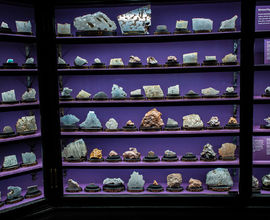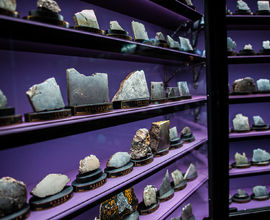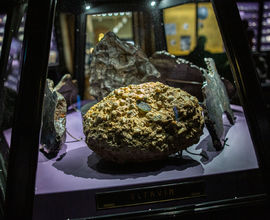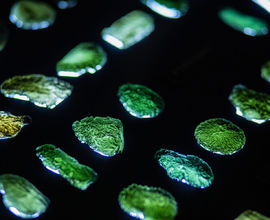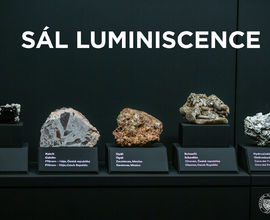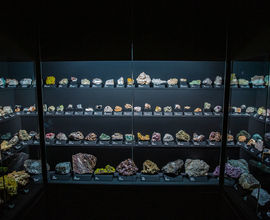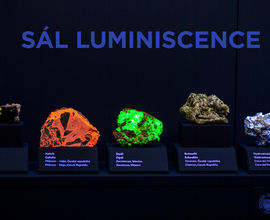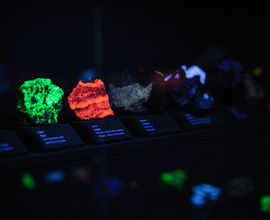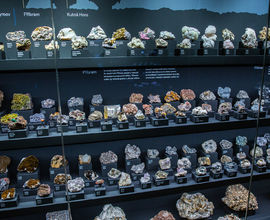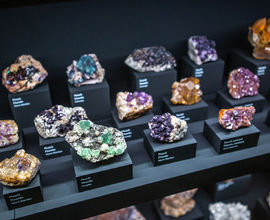Hall of Minerals | Hall of Meteorites | Hall of Luminescence | Mineral Recourses of Czech Lands
Hall of Minerals
This collection of minerals was one of the first collections to be donated to the newly established museum as early as 1818. The donor was none other than one of its main founders, Kašpar Count Šternberk and as the collecting of minerals was a passion among the nobility at that time, Šternberk's example began to be followed by other donations creating the basis of today's collection.
The first mineralogical exposition was opened thanks to the important Czech mineralogist Prof. Karel Vrba on the 28th of September 1892. Vrba worked closely with the architect of the entire builing, Prof. Josef Schulz, and together they designed the type of display cases that can accommodate more than 4,000 minerals, which can be found in this room. The whole exposition is organized in the same way as it was more than 100 years ago.
Interesting facts from the Hall of Minerals, which is a part of the new exposition of natural history:
- this is one of the oldest collections of minerals in the National Museum
- with more than 100,000 minerals, it is the largest collection in the Czech Republic
- in total, more than a third of all minerals originally exposed have been replaced
- these are of the most interesting items found within the entire collection
- only 4 % of the total collection is exhibited
- new labels are in the original gilded font
- all minerals have been professionally cleaned before being displayed
- more than 5,500 types of minerals have been recognized in the world so far but only 700 have been exhibited
Hall of Meteorites
The Hall of Meteorites is located in a smaller exhibition hall on the first floor of the Historical Building of the National Museum. It is connected to the neighbouring Hall of Minerals and the Hall of Luminescence, or the Windows into Prehistory – Quaternary.
In addition to the meteorites which are predominant in the room, the exhibition also includes tektites, both foreign and Czech moldavites, as well as terrestrial rocks and impactites (rocks altered by the impact of a large meteorite). All exhibits are installed in the original restored showcases from 1893 with a refurbished interior. The showcases are placed continuously at the walls around most of the perimeter of the exhibition hall. In the middle of the room, there is a dominant, also original – historical, hexagonal showcase with examples of large meteorites. On the top of it is a bronze bust of Karel Vrba, the founder of the National Museum's meteorite collection. The central showcase is dominated by a 69 kg complete individual meteorite Canyon Diablo, it also contains slabs and cuttings of Toluca, Mount Joy, Gibeon, Tamarugal meteorites and a large piece of sandstone with an overgrown moldavite from the Vrábče sandpit.
The subdominant feature of the hall is the pedestal with the Argentine meteorite Campo del Cielo, which weighs impressive 83 kg. The meteorite is placed freely on the pedestal, i.e. uncovered, so that visitors can touch it. Another separate element of the room is a horizontal showcase with 155 selected backlit examples of Czech and Moravian moldavites from 29 sites.
Out of the 530 items in the museum collection 440 specimens of meteorites are on display as part of the exhibition. The two introductory showcases contain mainly texts and pictures introducing the issue of meteorites, impactites and tektites. In addition, they are dedicated to two historically observed falls of meteorites, namely Ensisheim (France 1492) and Mauerkirchen (Austria 1768). Both of these meteorites are also presented in the form of physical specimens.
The next ten showcases present meteorites arranged systematically, i.e. undifferentiated meteorites (“immature”: carbonaceous and ordinary chondrites) and then differentiated meteorites (“mature”: achondrites, mesosiderites, pallasites and siderites) respectively. Among the chondrites, the visitor should not miss the outstanding example of the famous carbonaceous chondrite Orgueil, which impacted in France in 1864. Four examples of Martian meteorites or two lunar meteorites should not escape the visitor's attention either. Among the pallasites, four meteorites of Krasnoyarsk will certainly be of interest. Throughout the exhibition, the exhibited stones are interspersed with explanatory labels with texts and pictures.
One showcase is dedicated to meteorites with a pedigree, i.e. those that have a calculated orbit in the solar system and a place of impact on Earth. The leading experts on this issue are traditionally Czech astronomers, starting with Zdeněk Ceplecha and his followers Pavel Spurný and Zdeněk Borovička. A total of ten meteorite specimens are on display in this showcase, and more should be added in the near future thanks to the planned new acquisitions into the museum collection and also a loan from the Astronomical Institute of the CAS.
Two showcases are dedicated exclusively to Czech meteorites (a total of 49 pieces), which come from a total of 18 areas such as Elbogen, Blansko, Tábor or Lysá nad Labem. One showcase is then dedicated to impactites (a total of 23 specimens). Suevites, kärnäites, shatter cones, desert glasses, irgizites and other impact rocks can be seen here.
In the following two showcases, 81 samples of the largest and also the most beautiful Czech and Moravian moldavites from the collection of the National Museum are untraditionally displayed on pedestals. Among them is, for example, a moldavite from Strpí (111 g) or a Moravian moldavite from Kožichovice (235 g) (there is a total of 236 moldavites in the entire exhibition). The oldest documented moldavite in the collection of the National Museum is also on display. It comes from Dolní Chrášťany and is perched with a large open bubble on the edge of a flat pebble with which it was allegedly found. In 1891, this moldavite was acquired by Josef Kořenský at the General Land Centennial Exhibition in Prague who donated it to the National Museum.
Two showcases are also dedicated to foreign tektites, among which indochinites predominate, but there are also philippinites, a javaite, billitonites, australites, tasmanites, bediasites and georgiaites. Terrestrial rocks are on display in the last three showcases. These were created by the gradual transformation of the original primordial matter, which we encounter today in the form of meteorites – chondrites. Selected rock specimens are presented here, on which certain geological processes can be clearly demonstrated, in several cases these processes are briefly outlined in the accompanying text labels.
Hall of Luminescence
The chamber exhibition Hall of Luminescence, located on the first floor of the Historical Building of the National Museum between the Hall of Meteorites and the Windows into Prehistory –Quaternary, presents a remarkable property of some minerals, namely their interaction with ultraviolet light. UV light is invisible to the human eye, but when it hits certain types of minerals, they start to emit light of different wavelengths which we can see. This phenomenon is presented in a dark room where normal lighting alternates with short-wave and long-wave UV radiation. Thanks to this, one can experience a surprising colourful spectacle.
Mineral Resources of Czech Lands
The Mineral Resources of Czech Lands exhibition is accessible from the Windows into Prehistory – Paleozoic. Each of the four corners of the Hall of the Mineral Resources of Czech Lands is dedicated to one raw material, previously mined to a significant extent in the territory of the Czech Republic, i.e. gold, silver, tin and uranium. Exhibited here are mainly minerals (about 800 specimens) from the deposits of these metals, the most beautiful ones which are to be found in the collection of the National Museum. Specimens of gold from Křepice, Jílové and Roudný and some accompanying minerals from gold deposits are presented in the showcase dedicated to gold. Concerning tin, there are minerals from Horní Slavkov, Cínovec and Krupka. Showcases dedicated to uranium and silver contain exclusively minerals from the deposits of Příbram and Jáchymov. In the hall, you can also see products made of gold, silver, tin or uranium glass and items related to mining.
The dominant feature of the room is a showcase located in its centre. It displays specimens of uranium ore uraninite from Jáchymov, tin ore cassiterite from Horní Slavkov, silver ore proustite from Jáchymov (unique, the so-called “imperial proustite” – a large druse donated to the museum by Emperor Francis I in 1820), and the largest sheet of Křepice gold, a nugget from Jílové and a bowl with gold mined from the river Otava.

